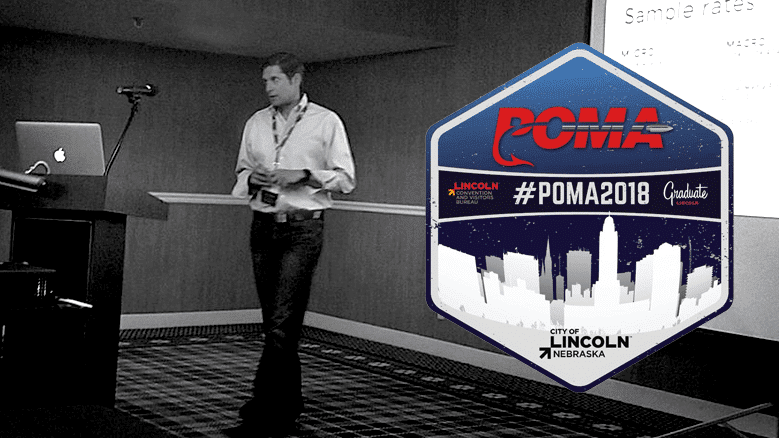
I recently had the privilege to present to the Professional Outdoor Media Association on the topic of “How to Become a Better Influencer in the Outdoor, Hunting and Firearms Industry” in Lincoln, Nebraska, June 14, 2018.
Influencer marketing is changing in the outdoor, hunting and firearms marketplace due to increased interest, fakenews, and social media algorithm changes. If you’re new to influencer marketing, this talk showed you how to leverage this highly effective marketing tactic more efficiently for yourself and the brands you manage. I presented the latest trends, tools and insights, and how to track and charge/price accordingly.
Over the past 5 years, I’ve been fortunate enough to build a small pocket of influence with hundreds of marketing professionals and executives in the industry. I also work with some of today’s most popular influencers. This has provided me a unique insight into the workings of influencer marketing in the outdoor, hunting and firearms industry.
Below are eight points (and my slides) I gave to an audience that included writers, influencers, marketers, photographers and content creators on how to strengthen, grow and optimize their personal brand’s influence.
1. Define your Niche
What is your area of specialty and interest, what is your focus? What area of the outdoor are you most passionate about?
For example, when I switched my agency focus to firearms, hunting and outdoor—I made our agency stand for something that stood out among other “all purpose” digital agencies. This allowed me to do a few things:
- I repelled prospects from other industries I didn’t want to work with, while attracting prospects and qualified leads from the outdoor industry.
- Broke through the clutter with a defined message and industry expertise.
- If you’re a photographer or writer who covers all things hunting and fishing, I strongly suggest you narrow your focus on what you’re most passionate about. For example, you may only want to focus on Wolves, Big Horn Sheep or Mule Deer Photography.
- Let your personality come through, don’t be afraid to be you.
2. Set Goals
I’m big on the SMART Goal method (Specific, Measurable, Attainable, Realistic and Timely). You may want to grow your audience by a million followers in one month—but that may not be realistic. Set your goals and work towards them on a daily basis with consistency. Make sure you have a goal post.
Always remember to write your goals down! If you don’t write them down they don’t exist.
3. Know Your Audience
Over time, you’ll get a good feel for your audience. You’ll understand what makes them tick, what problems they have and why they find you interesting.
- Take at least 10 – 15 minutes and engage once a day.
- Influence is nothing without engagement.
- Use Instagram, Twitter and Facebook’s built in analytics to help you understand age, location and interests.
4. Be Helpful—Don’t Sell
In order for influencers to persuade, you must become a solution provider.
When I started doing inbound marketing for my digital agency, I looked to help my prospects first. That in turn earned their trust and allowed me to position myself as a solution provider and a partner in growth. It’s always a service, never a sell.
Furthermore, if you love the brands you represent and believe in them, your audience will naturally love them too because you’re not necessarily selling someone, you’re adding value to their lives.
For more information on how to perfect the art of persuasion, check out Adversaries to Allies, By Bob Burg
5. Be Authentic and Honest At All Costs
Never sacrifice your audience’s trust at the product or brands expense. If the product breaks or is faulty, you may find yourself in a tight spot. So always test the products you’re considering before signing that contract. Posture your clients by being brutally honest if the product doesn’t work and outline what the ramifications are.
6. Build a Website and Blog!
This past week, we saw Brownell’s YouTube channel removed from YouTube—and then, fortunately it was reinstated.
With all the anti-hunting/anti-gun social media channels out there—don’t rely on these third party channels. So many influencers are building their livelihoods on these third-party apps that can shut you down right now and for any reason.
Blog – When considering influencers to work with, I look to see if they have blogs that are updated consistently. Blogs provide content that work for your brands 24/7/365. They also build links and gives your visitors the ability to share information more efficiently.
Affiliate links – Blogs are also great for placing affiliate links that help you generate more revenue.
Contact Information – Make sure you have your contact information available within your Instagram/Facebook/Twitter profiles so brands can contact you. So many influencers out there give no way for people to get in touch with them.
7. Create a Good Mix of Content
- Instagram video consumption has increased 40%
- Photos generate 36% more likes than videos
We all know content is gold. Your content must add value to your audience. Create a good mix of high-quality video and photos. (Source: SproutSocial)
Make sure to always tag your content with a #sponsored or an #ad tag to remain in compliance with the FCC. Influencer marketing is still like the Wild Wild West, so make sure to stay up to date on any changes.
8. It’s not About You.
At the end of the day, if you’re not adding value to your audience, you’ll start to see your followers level out. When you truly grasp this—your entire mindset will change. (Source: Julie Solomon)
“Influencer marketing is not about you, it’s about them.”
About The Professional Outdoor Media Association (POMA)
Whether you’re a hunting and fishing industry communicator, industry professional or an avid outdoor sports enthusiast, POMA is working hard for you. POMA is dedicated to seeing the traditional outdoor sports story is told honestly and fairly so hunting, fishing, the shooting sports and trapping will endure. Learn more on their website and sign up today!
Photo Credit: Tony Bynum



